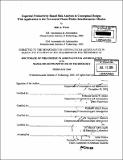| dc.contributor.advisor | David W. Miller. | en_US |
| dc.contributor.author | Wertz, Julie (Julie Ann), 1978- | en_US |
| dc.contributor.other | Massachusetts Institute of Technology. Dept. of Aeronautics and Astronautics. | en_US |
| dc.date.accessioned | 2008-01-10T17:29:18Z | |
| dc.date.available | 2008-01-10T17:29:18Z | |
| dc.date.copyright | 2005 | en_US |
| dc.date.issued | 2006 | en_US |
| dc.identifier.uri | http://dspace.mit.edu/handle/1721.1/35590 | en_US |
| dc.identifier.uri | http://hdl.handle.net/1721.1/35590 | |
| dc.description | Thesis (Ph. D.)--Massachusetts Institute of Technology, Dept. of Aeronautics and Astronautics, February 2006. | en_US |
| dc.description | Page 238 blank. | en_US |
| dc.description | Includes bibliographical references (p. 233-238). | en_US |
| dc.description.abstract | During the design process, risk is mentioned often, but, due to the lack of a quantitative parameter that engineers can understand and trade, infrequently impacts major design decisions. The definition of risk includes two elements - probability and impact. As a result of heritage techniques used in the nuclear industry, risk assessment in the aerospace industry is usually purely reliability based, and is calculated as the probability of a failure occurring before the end of the design lifetime. While this definition of risk makes sense if all failures result in the same impact, for many non safety-critical systems, the impact of failures may vary, including variance by when a failure occurs. While current risk assessment techniques answer the question "What is the probability of failure?", the true question that needs to be answered for many missions is "How much return can be expected?" Depending on the question answered, the relative ranking of risk items may be different - leading to different risk mitigation investment decisions. Consequently, to complete an accurate risk assessment, it is important to combine system performance and reliability, and model the probabilistic nature of the expected value of the total system productivity. | en_US |
| dc.description.abstract | (cont.) This expected value is defined as the expected productivity. While the expected productivity is easy to calculate for simple systems, it is more complex if a system has a path-dependant productivity function, as is the case with many aerospace systems. In these systems, the productivity in each state depends on the previous states of the system. An approach, called Expected Productivity Risk Analysis (EPRA), has been developed to model the systems described above in an efficient manner by finding the expected path, and then find the expected productivity given that path. EPRA has been tested against conventional Monte Carlo simulations with excellent results that consistently fall within the 95% confidence interval of the Monte Carlo results, while completing the simulation up to 275 times faster. The EPRA approach has been applied to two case-studies, to demonstrate the importance of using expected productivity in a trade study for a real mission, the Terrestrial Planet Finder Interferometer. | en_US |
| dc.description.statementofresponsibility | by Julie A. Wertz. | en_US |
| dc.format.extent | 283 p. | en_US |
| dc.language.iso | eng | en_US |
| dc.publisher | Massachusetts Institute of Technology | en_US |
| dc.rights | M.I.T. theses are protected by copyright. They may be viewed from this source for any purpose, but reproduction or distribution in any format is prohibited without written permission. See provided URL for inquiries about permission. | en_US |
| dc.rights.uri | http://dspace.mit.edu/handle/1721.1/35590 | en_US |
| dc.rights.uri | http://dspace.mit.edu/handle/1721.1/7582 | |
| dc.subject | Aeronautics and Astronautics. | en_US |
| dc.title | Expected productivity-based risk analysis in conceptual design : with application to the Terrestrial Planet Finder Interferometer mission | en_US |
| dc.type | Thesis | en_US |
| dc.description.degree | Ph.D. | en_US |
| dc.contributor.department | Massachusetts Institute of Technology. Department of Aeronautics and Astronautics | |
| dc.identifier.oclc | 74895972 | en_US |
